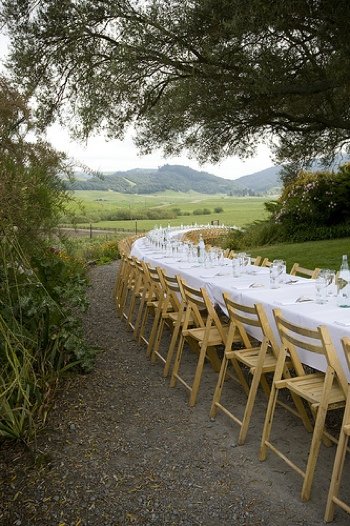Growing up picking apples and pears with his older organic farming brother gave Jim Denevan the green thumbs and love of food that made him a pioneer in the culinary world. The fact that it all started because this 17-year-old surfer needed to earn money to buy a wetsuit is irrelevant.
The sibling-inspired “super passion” was further cultivated in the 1980s in Italy, where he lived on farms, cooking and eating products fresh from the land. Inspired to recreate that farm-to-table experience in the States, Denevan started Outstanding in the Field, a chichi yet down to earth way of celebrating the food and where it came from—with the help of award-winning guest chefs who devise the feast.
In anticipation of the OIF series heading to the East Coast this summer and fall, we dialed Denevan in Santa Cruz, California to see what was cooking with the surfer dude 10 years after his first sustainable alfresco dinner.
What are some of your earliest memories that led you to create OIF? Well, in Europe I became interested in the culture of food, something that was not yet really prevalent in the US. I wanted to promote that connection between growing perfect apples, organic farmers talking proudly around the table about their food, and the guests enjoying the whole menu that originated from the farm.
How did you come up with the title? I still have a piece of paper with 30 or 40 names on it. Some silly cutesy names, but I ended up with Outstanding in the Field because I thought it was an excellent example of what [local farmers] do. I liked the literalness of it.
Any highlights of the upcoming dinners you can mention? Tim Stark in Hamburg, PA started growing tomatoes in his Brooklyn apartment before he moved out to the country, so tomatoes will be a strong part of his menu. It could be a soup or it could be tomato ice cream, a cherry tomato ice cream. In Queens, the first vintage wine will be served from the vineyard on site. In Long Island, guests will dine on striped bass in a corn field.
You are also an artist who exhibited at P.S.1/MOMA. Do you ever bring an artistic approach to these events? It’s usually up to the chef to structure the meal around the ingredients on the property where we’ll eat. Makes it more interesting and fun when the local purveyors get up for a few minutes during the five course meal to talk about what they do—be it the fisherman, the beekeeper, the cheesemaker. It really adds to the culinary experience, gives farmers a hook.
 What happens before we eat? We take guests on a tour of the property, about 25 minutes, over hills, around trees, then suddenly they see the table. A bit of theater.
What happens before we eat? We take guests on a tour of the property, about 25 minutes, over hills, around trees, then suddenly they see the table. A bit of theater.
Over the mountains and through the woods. . .should people bring anything with them? A bonnet or beekeeper veil? Foraging in the woods there’s not a big issue with bugs. And if it is, that’s part of the adventure. You could bring non-toxic bug spray, sensible shoes, a hat, sunscreen, layers. When you purchase a ticket, it’s all very informative.
When people are on the road traveling, do you have any tips for ways they can support local farmers? Know who the local producers are and try to visit those different places. There’s LocalHarvest.org—a database of local farms and producers—and it has a map of the whole country. Tells you where to find an artisan cheesemaker or farmers market.
Do you have a motto? Go the extra distance. My brother Bill didn’t just want to grow apples, he wanted to grow the most delicious most beautiful apples. Good as they can be. I take that same level of obsession as he had with apples and translate it to the field.
You have a new book out, “Outstanding in the Field: A Farm to Table Cookbook.” Any yummy organic recipe you can give to our readers? Goat Cheese Crostini with Sweet Pea Pesto: Makes about two dozen crostini; serves 8 to 12
2 Tbsp. pine nuts
1 cup of shelled fresh sweet English Peas (from 12 ounces to 1 pound peas in the pod)
1 small clove garlic
2 Tbsp. packed fresh flat-leaf parsley leaves
2 Tbsp. packed fresh chervil leaves
About 4 Tbsp. extra-virgin olive oil, plus more for serving
Kosher salt and freshly ground black pepper
1 Baguette
5 ounces soft, fresh goat cheese
Heat oven to 400 degrees Fahrenheit. Spread the pine nuts on a baking sheet and toast in the oven until golden, 3 to 5 minutes. Transfer the nuts to a plate and set aside to cool. Increase the oven temperature to 425 F. Bring a pot of salted water to a boil and prepare a bowl of ice water. Cook the peas in the boiling water until very tender but still bright green, 2 to 6 minutes. Drain the peas and immediately transfer them to the ice water to stop the cooking. When they are cool, drain and dry them on a towel. In a mortar, use a pestle to pound the garlic clove with a pinch of salt to a paste. Add the peas and pound into a paste, adding a little olive oil to help if necessary. Transfer the mixture to a medium bowl. Add the pine nuts to the mortar and pound them briefly to break them up, but do not pound them to a paste; they should still have a bit of texture. Add the nuts to the pea mixture. Coarsely chop the parsley and chervil and add them to the bowl. Stir in enough olive oil to loosen the pesto but not enough to make it runny. Season with salt and pepper to taste and set aside. Slice the baguette into 1/4 inch slices. Arrange the slices on a baking sheet, and toast in the hot oven until golden, 6 to 8 minutes. Cool slightly. Spread about 1/2 tsp. of the goat cheese on each crostini and grind some black pepper over the cheese. Arrange the crostini on a platter and top each with about 1 tsp. of the pesto. Drizzle with some olive oil and serve.
How to get there: Visit outstandinginthefield.com to make a reservation, ask for directions, and explore other locations. Tickets sell out fast and are around $200. If you’re going to carpool or see the surrounding sites, check out oM’s guide to renting hybrids in NYC.
The co-founder and editor-at-large at offMetro, Lauren is a sustainable travel specialist and freelance journalist with frequent bylines in National Geographic, Bicycling Magazine and Shape. Follow Lauren’s adventures at @laurenmati.










 Sarah Knapp is a Brooklyn based entrepreneur whose love for the outdoors and community building led her to the October 2013 creation of OutdoorFest. She has a BA in History, is a Wilderness First Responder and a NY state hiking, camp and boating guide. Her proudest achievement to date is reading the Aeneid in Latin.
Sarah Knapp is a Brooklyn based entrepreneur whose love for the outdoors and community building led her to the October 2013 creation of OutdoorFest. She has a BA in History, is a Wilderness First Responder and a NY state hiking, camp and boating guide. Her proudest achievement to date is reading the Aeneid in Latin.  Allison was one of our first top writers and Chief Editor but is no longer working with offMetro. Allison is a native New Yorker, who has lived in Rome, Tuscany, Melbourne, Toronto and Los Angeles. She frequently contributed travel pieces to Family Travel Forum, using her own children as guinea pigs as they travel the globe. She never missed a chance to sample local delicacies, as her love for travel goes hand-in-hand with her love for food and wine.
Allison was one of our first top writers and Chief Editor but is no longer working with offMetro. Allison is a native New Yorker, who has lived in Rome, Tuscany, Melbourne, Toronto and Los Angeles. She frequently contributed travel pieces to Family Travel Forum, using her own children as guinea pigs as they travel the globe. She never missed a chance to sample local delicacies, as her love for travel goes hand-in-hand with her love for food and wine.  Josh Laskin is a freelance travel writer and photographer based in the White Mountains of New Hampshire. When he is not at work or on the road, you can find him in the mountains snowboarding, climbing, hiking, fly fishing, mountain biking, and eating bagel bites.
Josh Laskin is a freelance travel writer and photographer based in the White Mountains of New Hampshire. When he is not at work or on the road, you can find him in the mountains snowboarding, climbing, hiking, fly fishing, mountain biking, and eating bagel bites. Annie is a travel writer, environmentalist, and surfer based in Venice, CA. She heads up our West Coast team, keeps our grammatical errors in check, and makes sure our California writers always have a plan for their next adventure. Follow Annie’s travels @annelisemcb.
Annie is a travel writer, environmentalist, and surfer based in Venice, CA. She heads up our West Coast team, keeps our grammatical errors in check, and makes sure our California writers always have a plan for their next adventure. Follow Annie’s travels @annelisemcb. Carly Pifer is a freelance writer who has been known to follow whims inspired by romantic movie scenes or colorful street style shots to India, Japan, Tunisia and Argentina. After stints living in Seoul, Boston, Paris and Los Angeles, writing and searching for something intangible, she landed somewhat steadily in Brooklyn and has begun to find inspiration in her more immediate surroundings.
Carly Pifer is a freelance writer who has been known to follow whims inspired by romantic movie scenes or colorful street style shots to India, Japan, Tunisia and Argentina. After stints living in Seoul, Boston, Paris and Los Angeles, writing and searching for something intangible, she landed somewhat steadily in Brooklyn and has begun to find inspiration in her more immediate surroundings.  Kate E. O’Hara is a New York based freelance writer and photographer who loves all things food—especially the people who make it and market it. Her writing aims to capture the essence of the food experience; the stories that go well beyond a plate of ingredients. In addition to her love of food, Kate is also known to have a hankering for red wine and craft beer. You can also find Kate on Instagram
Kate E. O’Hara is a New York based freelance writer and photographer who loves all things food—especially the people who make it and market it. Her writing aims to capture the essence of the food experience; the stories that go well beyond a plate of ingredients. In addition to her love of food, Kate is also known to have a hankering for red wine and craft beer. You can also find Kate on Instagram